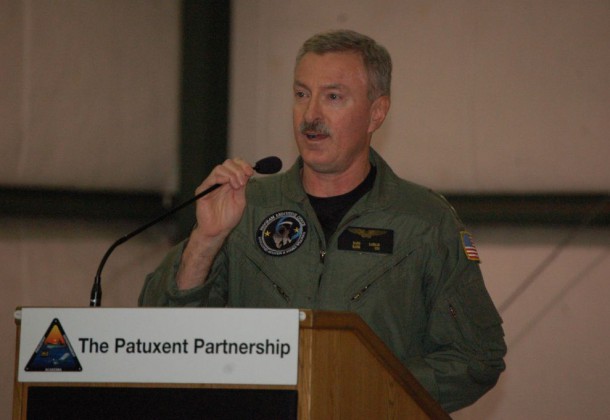Electronic Warfare Defines the New Battlespace

The bad news: Russia and China are outpacing the US in development of electronic warfare technologies, signal elements defining the current and future battle space.
The good news: The US has the technology to reclaim an undisputed lead in “battle space knowledge,” RADM Mark ‘BamBam’ Darrah, PEO of Unmanned Aviation and Strike Weapons said, opening a panel discussion titled “Electronic Attack = Assuring All Domain Access,” held last week, at the Patuxent River Naval Air Museum.
This was the 26th Patuxent Partnership/Association of Naval Aviation (ANA) Squadron #18 joint panel open to the community, and included a collaboration with the Association of Old Crows.
The briefing centered on today’s technologically dependent regime. Denial of electronic means impedes the ability to function effectively. Deny, monitor, manipulate and evaluate are pieces of Electronic Warfare (EW).
Electronic Attack is the offensive suppression of an adversary’s electromagnetic spectrum, focused primarily on radars and communications. Since World War II, the EW mission has existed in basic methods such as chaff, a rudimentary noise jamming technology. Today, Navy operations utilize Airborne Electronic Attack platforms such as the EA-18G Growler due to its capacity to operate in high threat environments.
Joining RADM Darrah, the keynote speaker, were RDML (Select) Frank “Spanky” Morley, Vice Commander, Naval Air Systems Command (former F/A-18 and EA-18G program manager); CAPT John “Bails” Bailey, Program Manager, EA-6B and Next Generation Jammer (PMA-234); CDR Lee “Spaulding” Jackson, Airborne Electronic Attack Requirements Officer (OPNAV N2N6); and CDR Chris “Needles” Bahner, EA-18G Mission Planning Requirements Officer (OPNAV N98).
The officers conveyed a sense of urgency, the core need to bring new thinking to existing technologies. According to the speakers, new platforms need to be developed that combine those technologies in new ways. Platforms must communicate among one another, and each component must receive the communications it needs in a relevant manner.
For example, the pilot in the cockpit needs a specific part of the data, not more or less. However, all of the data needs to be accessible to every participant in the battle space at all times.
RADM Darrah told the standing room only briefing, Chief of Naval Operations, ADM John Richardson described what is necessary as “informationalizing” the Navy, a Chinese military-theoretical term, according to Breaking Defense.
RDML (Sel.) Morley also emphasized that the Department of Defense has “pockets, communities” that possess the relevant information, but this knowledge is “not yet all linked. The real magic is when you can tie these things together.”
He gave as an example the knowledge of radar since the beginning of World War II, but not until Britain figured out how to apply it as a defense net, tying it together, was it the effective technology it proved in the Battle of Britain, considered the deciding battle that saved the war for the Allies.
“We need to bring in others,” Morley said, emphasizing a theme with all panelists. New types of thinking to put existing technologies to use in new ways is needed. But classified data, historically the different forces have not shared information. It is more unusual than not for programs within each force to share information. These obstacles must be overcome internally, Morley said. In addition, external to the military, the commercial sector – such as Silicon Valley – must be brought into the development mix. This complicates the classified nature of the work even further.
But it must be done, said Morley. “We aren’t just losing our favorable technology gaps,” he said, nor is it any longer that other nations are taking our technology and adapting it. Our enemies are developing their own, effective technologies. We need to get ready for playing hurt.”
CAPT Bailey presented the same message regarding Electromagnetic Maneuver Warfare. There are three bands in the electromagnetic spectrum, he explained. There’s the mid-band where the majority of threats take place. The US has most of the knowledge it needs to work effectively in this band but hasn’t yet turned the knowledge into tools for the warfighter.
“We’re behind the threat, late to the game. It’s not just our pace. The warfighter needs the tool,” Bailey said.
It’s been a slow start on the second increment, the low-band width, but this is ramping up. For the high band, there is no funding yet.
Both CDR Jackson and CDR Bahner, explained in the wrap-up presentations, “It’s all about the budget at the Pentagon,” Bahner said.
Despite the threats and imperatives, CDR Jackson echoed others encouragement from the team working behind the EA-18G, Growler, the best integrated aircraft in the system, according to Jackson And until the Navy’s F-35 comes online, it remains the best electronic warfare support measure, he said.
That same commitment is going into development of the Next Generation Jammer (NGJ), following on lessons learned from the Growler.
The Navy will accomplish this, Darrah said in conclusion, , reiterating that the knowledge and capability exists but needs to be applied in new ways. “We need diversity of thinking. That’s where innovation comes from.”
To learn more about The Patuxent Partnerships and its programs visit their Leader Page.























